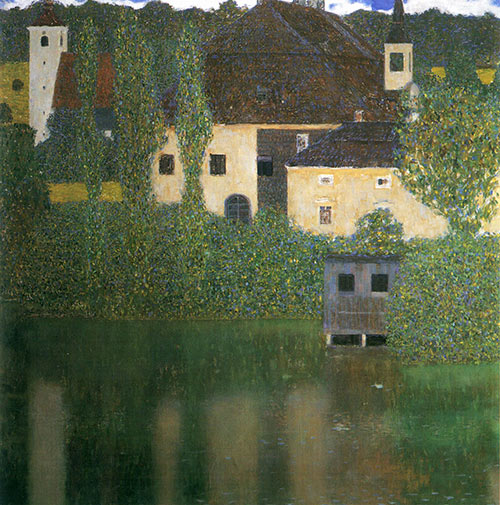Water Castle
The revolutionary artwork of Gustav Klimt seizes an array of genres of art while incorporating lush colours and techniques.
The landscape painting was created in 1908 during the period of Klimt's gold phase, incorporating elements of Art Nouveau into his work. The 110cm x 110cm oil on canvas artwork showcases the artist's impressionist technique when it came to showcasing the elements of nature. The intercut artistry manifests the artist's classic style depicting the natural flow of the environment around him.
Gustav Klimt had spent his summers running away to the countryside of Austria, in the regions surrounding Lake Attersee. The prominent artist was seized by the dazzling setting he was surrounded in, always retuning each summer. The artist would commonly abandon who he had travelled with, and focused on his own exploration to find the perfect places to paint art. The target of Klimt was to find beautiful checkpoints and locations to set up his tools and paint the scene in front of him. The artist usually woke up everyday at 6am and hikes through the deep forests, meadows, and fields.
The painting Water Castles showcases the lush greenery that surrounds the artwork. The setting of the castle was most likely based upon Lake Attersee, in which an array of the artist's work is based upon, including Attersee, Church in Cassone, and Mountain Slope on Unterach. These paintings follow the impressionist style of Water Castles while based on the prominent lake.
The painting unravels a cream coloured castles based upon a large hill. A rich green coloured bush, breaking into a water gate, surrounds the castle. The castle is believed to be surrounded fully by the water. The location of the painting adds to the curiosity of the viewer as they ponder the history behind the painting. Questions up rise such as: Who lives there? How did Klimt find the location? Was he perhaps seemed as a suspected enemy? These array of questions are the exact element the artist worked to obtain through his paintings.
The walls of the castle are based on the natural vegetation of the scenery, painted in a mosaic style. Green is held as the primary colour, ranging from light to dark green covering the bush. The artist adds a few hints of blue to the vegetation to add colour to the piece as the mosaic tone that it is missing. The brush strokes that the artist used to illustrate the piece is critical element to witness in order to understand his classic style. The artist lightly dabs the canvas with his brush in an upward technique to achieve the form. All of the vegetation within the painting is achieved through this spongy technique. Through these dabs, the illusion of a little circles all clustered together is created.
The artist continued his masterful technique by showcasing water within the painting as a reflection of the environment around. The water lightly mirrors the bushes and building. The artist used a realist approach to depict the surface of the water, while lightly blending in the reflect colour. The water is covered in a sharp sheen, lightly resembling the artist's previous work. The castle illustrated throughout the painting is shades in a creamy white colour, manifested in Klimt's impressionist style used within landscapes. Klimt achieves depth within his work through the use of the water, lightly flowing towards the gate. Gustav Klimt's soft touch to the canvas illuminates the artwork through an array of cool tones.




